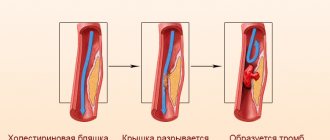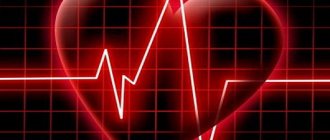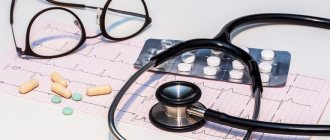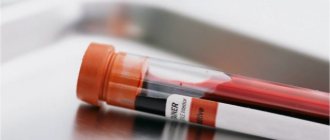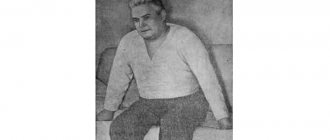In the classic course of a heart attack, there is a certain connection between the period of its development and fluctuations in blood pressure. Even an experienced specialist cannot say exactly what pressure and pulse are during a myocardial infarction. A clear relationship between changes in its level and the progression of tissue necrosis has not been established. An attack can develop both when blood pressure is relatively normal, and when it is elevated or decreased.
It is assumed that the “behavior” of pressure depends on the patient’s tendency to arterial hypertension before a heart attack. That is, in hypertensive patients it, as a rule, increases during an attack; in people with normal blood pressure, blood pressure remains within the normal range or slightly exceeds it.
Clinical signs of myocardial infarction are often vague. The situation is the same with blood pressure: not in all cases it increases and decreases according to the classical pattern.
General information about the disease
For every thousand men, on average, up to five are affected by myocardial infarction. For women, the indicator is slightly lower - necrosis of the heart muscle occurs in one in a thousand representatives of the fair sex.
The disease most often provokes the appearance of a blood clot in the coronary artery. In addition, among the reasons are:
- arterial spasm;
- arterial dissection;
- entry of foreign bodies into the artery.
In some cases, stressful situations or disproportionate physical activity lead to the disease.
How to suspect?
A heart attack with low pressure is accompanied by sternal pain, the duration of which is from a quarter to a third of an hour. The sensations do not go away even if the patient takes nitroglycerin. Many said that they were haunted by the fear of death.
In some cases, the pain seems to be bursting from the inside, while others say that the sensations are squeezing. In any case, the pain is burning and acute. The pain radiates to the jaw, arms, and neck. In some cases, the epigastric part is affected. But sometimes there is no pain at all. This happens in almost a quarter of all cases known to medicine.
Pressure changes
People often notice low blood pressure after a heart attack. The situation is typical if no measures were taken for the disease, and they did not seek help from doctors. It’s easy to explain this phenomenon: due to a heart attack, the functioning of the circulatory system is disrupted, as the coronary vessels decrease in diameter, the throughput decreases, and the system as a whole is greatly weakened. The vessels become inelastic. In medicine, this condition is usually called “decapitated hypertension.”
Even if high blood pressure provoked a heart attack, if after it there is a frequent decrease in pressure, you need to remember that the situation leads to:
- arrhythmias;
- increase in heart size;
- swelling of the lower extremities;
- renal failure.
Low blood pressure is a serious problem
Remember, if the pressure during a heart attack becomes low, this leads to a general change in condition. It will no longer be possible to return to your previous health, even if you completely follow the doctor’s recommendations, take medications and practice physical therapy with enviable regularity. Unfortunately, science is not yet able to perform miracles. Remember, if you are offered a guaranteed full restoration of health, most likely you are dealing with scammers. Beware of such "experts".
Low blood pressure during a heart attack is one of the most severe symptoms, which is almost impossible to eliminate. Abnormal blood pressure can be detected by the following signs:
- general weakness;
- abnormal heartbeat (too fast or slow);
- dizziness;
- frequent yawning;
- chilliness of the limbs.
Remember that this clinical picture suggests a recurrence of the heart attack in the near future. To avoid complications, it is necessary to regularly measure blood pressure and see a cardiologist. When prescribing medications, you will have to follow the doctors' recommendations as closely as possible.
First aid
If characteristic signs indicating pathology appear, you should immediately call an ambulance. While waiting for a doctor, it is recommended:
- relax, don't panic;
- take Nitroglycerin for excruciating pain;
- chew one Aspirin tablet;
- use Validol to dilate blood vessels, improve blood circulation, and calm.
The attack is acute, in which a section of the heart muscle dies. If you seek medical help late, life-threatening complications may develop:
- tissue rupture in the affected area, cardiac arrest;
- ventricular fibrillation, in which the blood supply through the vessels and arteries is disrupted;
- heart failure leading to death.
To avoid such complications, do not ignore the manifestation of unpleasant symptoms.
What's first?
In most cases, in the first stages of development, the pressure during a heart attack in women rises to 140, but soon changes to low. The indicators show a sharp decrease on the second or third day of a heart attack, but never reach normal values. The most common diagnosis is pathologically low blood pressure.
If studies have shown a large-focal infarction, the pressure decreases sharply due to the fact that the resistance system in the vascular system is disrupted. In addition, disruptions in the functioning of the cardiohemodynamic system are observed.
Forecast
The outcome of the disease directly depends on the quick reaction of the patient himself or the people nearby. The faster the attack is stopped, the higher the chance of a favorable prognosis. Death occurs in approximately 1/3 of cases in elderly people who did not call an ambulance in a timely manner.
If you perform urgent actions within half an hour, the probability of a positive outcome is 60%. The prognosis can worsen significantly if the patient has severe concomitant pathologies.
Death most often occurs in women, because their attack is accompanied by nonspecific symptoms, which make it difficult to immediately suspect the development of a heart attack. Men suffer the disease more easily, although more often. At the same time, they often have a second attack, which in most cases causes death.
The development of pathology is disappointing
What pressure can the device show after a heart attack? In most cases, it is lowered, even if the person has suffered from high levels all his life. The myocardium cannot contract normally due to pathological changes, and cardiac output becomes significantly smaller.
But in the peripheral vessels the pressure increases. After a heart attack, high diastolic pressure is noted, and systolic pressure decreases below normal. However, rarely, but patients are observed whose pressure during myocardial infarction remains normal or decreases insignificantly. Doctors explain the resistance of individual patients to the structural features of the body, due to which hemodynamics do not change.
Clinical manifestations
In case of a heart attack, there is a high probability of cessation of the functioning of the heart muscle; the patient needs to receive first aid as quickly as possible. Most often, the pathology manifests itself in males over 45 years of age.
Myocardial infarction occurs in young people and is caused by prolonged vascular spasms.
If a person feels discomfort in the chest while playing sports, consultation with a medical specialist is required. Often the general condition returns to normal after rest; discomfort can make itself felt not only in the chest area, but also on the left side of the face, legs and elbows.
A small proportion of people associate the above-described clinical manifestations with disturbances in the functioning of the cardiac system. For this reason, treatment begins late. For this reason, if discomfort occurs during physical activity, a consultation with a cardiologist is required; angina pectoris is accompanied by a heart attack.
If pain occurs in the chest, it is recommended to call an ambulance. Angina pectoris is accompanied by blockages of blood vessels, which leads to a heart attack.
One of the signs of pathology is constant pain in the heart area. The nature of the pain can be compared to angina pectoris, and in the case of myocardial infarction, taking nitroglycerin has no effect.
There are a number of symptoms that indicate pathology:
- Angina pectoris takes a longer period than usual.
- The skin becomes pale and shortness of breath occurs.
- Patients report painful, compressive sensations during a heart attack.
The duration of attacks can vary - from a few minutes to 24 hours. The intensity of the attacks also varies; in some patients they are single, while others complained of multiple attacks that followed almost one after another.
For diagnosis, it is necessary to conduct a number of studies, as well as pass a number of tests. One of the clinical manifestations of myocardial infarction is arrhythmia. There are 2 types of symptoms of this disease. The first is typical clinical manifestations.
- Rapid pulse during a heart attack, or too weak heartbeat.
- Painful attacks, heart rhythm disturbances.
- Trembling, rapid breathing, increased activity of the sweat glands.
In this case, the pressure during a heart attack will be lowered, this is evidence of normal contraction of the muscle tissue of the heart.
Myocardial infarction is often accompanied by fear of death, the patient holds his breath, panic appears, and the body weakens.
The second category of clinical manifestations is atypical.
- Hiccups and nausea.
- Painful sensations in the upper abdomen.
- In some cases, vomiting is possible.
It is noteworthy that pain is a key symptom in diagnosing the disease. People suffering from diabetes do not have typical clinical manifestations.
A sure sign of a heart attack is temperature a day after the attack. This is explained by the death of particles that spread throughout the body, causing intoxication.
What is the pressure during myocardial infarction?
To summarize the above, we can say that during a heart attack:
- at first the pressure is higher than normal;
- on days 2-3 it decreases to levels below normal;
- remains low for a long period (all life).
A repeated sharp increase in pressure may indicate a secondary heart attack.
If you have a blood pressure of 140/90 or higher, then the risk of developing the disease is significantly higher than in people whose blood pressure is within the normal human norm.
If your daily blood pressure is below normal or within normal limits, readings exceeding 140/90 may already indicate a myocardial infarction.
So, what is the pressure during a heart attack? From 140/90 and above.
What are the forecasts?
There are transmural types of infarction (when the entire heart muscle is affected by necrosis) and non-transmural (when part of the myocardium dies). Deciphering the ECG, taking into account the time of onset of necrosis, suggests 4 stages.
- The most acute phase – from 20 min. up to 3 days.
- The acute period is the next 2-3 weeks.
- Subacute form – from 3 months to 1 year.
- Chronic (scarring) stage – for life.
Whether the prognosis will be favorable depends entirely on the promptness and adequacy of the assistance provided to the victim. The survival rate is directly related to the time before the ambulance appears.
Within 60 minutes, 30% of older patients (over 60 years old) die and the reason for this is untimely medical assistance. 13-20% do not survive even one month after an exacerbation, 4-10% die within 1 year after thrombosis.
If the patient received adequate help in the first 40 minutes, the chances of his recovery are up to 60%. Other diseases also play a role. If it is possible to help the clot dissolve in order to improve blood flow and nutrition of the heart muscle, the chances of healing will increase significantly.
Nonspecific symptoms give women less chance of a successful outcome. Although men recover faster, the risk of repeated heart attacks remains until one of them ends in death.
Symptoms of a heart attack
You can suspect that a heart attack is beginning if you experience pain in the sternum. It usually comes in fits and starts and is associated with thoughts of death. In some cases, the attacks are isolated, others suffer from a series of painful sensations. Sometimes the pain lasts only a minute or two, sometimes a day or longer.
Another sign of a heart attack is a rapid or slow pulse. In some patients it accelerates to hundreds of beats per minute, in others it slows down to only 50.
A decrease in pressure at the last stage of a heart attack allows us to draw conclusions about how much the heart muscle has been damaged by the disease. The lower the pressure, the more extensive the lesions, the longer the rehabilitation will be.
Why are women's symptoms different from men's?
Men are at greater risk for heart disease, and heart attack symptoms vary among women.
This is due to the fact that a woman’s heart is much smaller than a man’s. In addition, it beats faster. The number of beats of a woman's heart per minute differs from that of a man's by 15-20 times.
Another reason for the difference in symptoms is the production of the sex hormone estrogen in the female body, which provides additional protection to the coronary vessels.
www.syl.ru
What should you pay attention to?
Pressure during a heart attack is not the only sign that allows you to suspect the disease. In addition, doctors recommend urgently seeking specialized help if you notice:
- noise in ears;
- lack of air;
- rapid heartbeat;
- shortness of breath;
- spots, double vision;
- pulsates in temples;
- face is burning.
But if all the listed symptoms are present, and the pressure is normal, it is too early to calm down. It is likely that peripheral pressure and cardiac output balance blood pressure, however, myocardial infarction exists. Don’t delay seeing a doctor: it’s always better to be overcautious than undersafe.
conclusions
Among heart diseases, myocardial infarction occupies a special place. The development of pathology is associated with the condition of the heart and blood vessels. Timely assistance during an attack is one of the main factors in preserving the patient’s life.
Along with the general symptoms of the disease, there are signs that differ depending on the gender of the person. It is possible to stop the progression of the disease and improve the patient’s condition with the help of modern therapeutic methods.
Life after a heart attack will never be the same. It is necessary to adhere to a certain lifestyle to prevent the development of relapse.
Clinical picture after a heart attack
Since after a myocardial infarction almost all patients note a decrease in blood pressure, this affects the quality of life. You should be prepared for:
- Meteorological dependencies. The general condition becomes significantly worse if solar or magnetic storms begin, or the weather changes.
- Weakness, a feeling of “squeezed lemon”. People who have had a heart attack get tired very quickly, which is especially noticeable if a person spends his day at work. By the end of the shift, productivity is practically zero.
- Throbbing pain in the back of the head, temples. As a rule, this sensation is associated with low blood pressure and does not bother those whose blood pressure remains normal after a heart attack. In addition to pulsation, heaviness in the forehead and migraine in half of the head can also occur. The sensations are dull, last a long time, are accompanied by the urge to vomit, and cause drowsiness.
- Frequent numbness of the limbs. Legs and arms after a heart attack are often cold, sensitive to both low and high temperatures.
- Pain in the sternum, in the area of the heart.
- Absent-mindedness, memory problems, depression, emotional instability.
- Dizziness. Most often it accompanies a sharp rise (for example, in the morning from bed). The eyes become dark, spots appear, and the condition is as if the person is about to faint.
Why are women's symptoms different from men's?
To avoid the development of heart pathology, you should start taking measures at a young age. Prevention of primary and secondary types includes:
- to give up smoking;
- physical activity;
- rare alcohol consumption;
- proper nutrition;
- monitoring cholesterol and blood sugar;
- use of Aspirin or Heparin at increased risk.
Since the heart begins to work intermittently during a heart attack, and blood flows chaotically to the heart muscle, the pressure during a myocardial infarction must be measured constantly in order to understand what medical measures need to be taken at a particular stage of the disease.
Symptoms of a heart attack
Even educated people cannot always answer the question, does blood pressure increase or decrease during a heart attack? The generally accepted point of view is that blood pressure increases sharply during myocardial infarction. However, the general symptoms of this condition are:
- Reduced blood pressure. This occurs due to the fact that the heart cannot contract at the same rate. The presence of low blood pressure in combination with arrhythmia is considered one of the main symptoms of a heart attack.
- Pressing, sometimes unbearable acute pain in the left upper part of the body, spreading to the back, left arm, shoulder blade and neck.
- Very strong pain can provoke nausea, vomiting, fainting, and convulsions.
- If the patient remains conscious, then he experiences a state of panic, waves of fear for his life roll in, and cold sweat breaks out.
However, the symptoms of a heart attack may be atypical. In this case, the person’s stomach hurts as if pancreatitis is worsening, and breathing problems and arrhythmia may occur.
Sometimes this insidious disease occurs without any symptoms or changes in pressure at all, and only a timely ECG helps doctors determine that a person has a malfunction of the heart.
To understand how pressure and pulse change during a heart attack, you need to imagine the picture that occurs in the body at the time of the attack. The process is triggered by blockage of the coronary artery with cholesterol plaques.
Blood flow to the heart is disrupted, and after about 15-20 minutes, necrosis of the myocardium (the bulk of the heart muscle) occurs. A person suffers from terrible pain that cannot be relieved with painkillers.
The pressure during a heart attack first drops sharply, then a small jump occurs, after which myocardial systole is no longer recorded.
Depending on gender, heart attacks occur differently. During a heart attack in women, blood pressure and pulse may undergo minor changes.
Women experience breathing problems and heart failure, but the symptoms of the attack are vague.
This happens because women are much less likely than men to experience disturbances in the functioning of the heart, since by nature the female body is adapted to the fact that the heart will experience high loads from time to time (for example, during childbirth).
Can you have a heart attack with normal blood pressure?
The most dangerous and insidious condition is considered to be when heart attacks occur in the absence of any external signs. In this case, a heart attack is recorded at normal pressure.
This situation can occur with an illness such as type II diabetes mellitus, but is rarely recorded by doctors during examination. Asymptomatic heart attacks occur during sleep, around 5 a.m., when the load on the heart increases.
In this case, deaths are recorded more often than in normal times, because the relatives of the sick person do not have time to provide him with the necessary help.
What is the blood pressure after a heart attack?
Arrest of myocardial systole has serious complications. If this condition is not stopped in time and blood supply to the heart muscle is not ensured, the patient will develop the following signs of the disease:
- decrease in pressure after a heart attack down to zero values;
- weak chaotic pulse;
- anemia, or insufficient blood supply to the brain;
- a sharp decrease in a person’s body temperature;
- in case of incomplete closure of the bicuspid heart valve, signs of a tachycardia state are visible on the cardiogram;
- increasing tachycardia leads to the fact that the pressure during a heart attack increases, resulting in pulmonary edema, fibrillation of cardiac ventricular cells, and heart failure;
- subsequently, loss of consciousness occurs, which in 90% of cases leads to rapid death.
Such damage to the heart is called cardiogenic shock, and the main task of both doctors and relatives of the sick person is to prevent a situation that cannot be corrected. It is recommended to constantly measure blood pressure and pulse during a heart attack or any suspicion of it in order to discover how the performance of a person’s heart muscle is changing at the moment, and how he can be helped.
First aid
Heart disease is becoming “younger” every year, and if previously a heart attack could only occur in an elderly person or a patient with a congenital disease, today an unexpected attack is increasingly affecting young people. To provide timely assistance, you need to know how to identify a heart attack and what its first signs are.
Signs of a heart attack
Some people are familiar with such a disease as a heart attack - its symptoms and first signs cannot be confused with other diseases.
This disease affects the heart muscle, often caused by a disruption in its blood supply due to blockage of one of the heart arteries by atherosclerotic plaques. The affected muscle dies and necrosis develops.
Myocardial infarction is a dangerous condition with a high mortality rate. In women, the pathology occurs 4 times less frequently than in men. The condition requires urgent hospitalization, as minutes count. Knowledge of specific and nonspecific symptoms, one of which is pressure during a heart attack, will help you suspect a dangerous disorder in a timely manner.
Symptoms of myocardial infarction
A heart attack is a lesion of the heart caused by a cessation of blood supply to the organ, which is explained by a blockage of the cardiac artery. Impaired blood circulation and oxygen supply to part of the heart muscle leads to the development of its necrosis, that is, the process of tissue death begins.
As a rule, necrotic changes occur half an hour after the blood flow stops.
What to do?
Medicine offers several treatment options for those who have experienced myocardial infarction. But effective methods for preventing this disease have not yet been invented. There are several methods of prevention that show greater or lesser effectiveness, which depends on a number of factors, including the individual characteristics of the human body. Usually it all comes down to a healthy lifestyle and physical activity (jogging, exercise, swimming).
During a heart attack, it is important to exclude physical and psychological stress. If the symptoms described above are present, you should consult a doctor and report your serious condition. The doctor will probably change the prescribed course of therapy.
Non-drug methods
Since heart attack patients are prone to sudden drops in pressure, it is recommended to always keep a supply of tea or coffee (to taste) on hand. When the pressure drops, you should brew a strong drink and drink it, while trying to calm down and drive away panic.
Doctors recommend drinking ginseng extract whenever possible. This product has proven to be a good pressure regulator.
If there is no effect, you should urgently call a doctor. As a rule, persistent low blood pressure in the post-infarction state indicates the approach of a second attack.
To prevent this, you can try one of the newest developments in the field of medicine - blood ozonation. Another novelty of doctors is a special pressure chamber. Such measures help return blood pressure to levels close to the norm. Positive effect on the immune system.
Who should be especially careful?
The risk of developing myocardial infarction is highest if a person belongs to a risk group. These include:
- diabetic patients;
- smokers;
- having excess weight;
- suffering from high blood pressure.
Those who naturally have high blood pressure are most likely to have a heart attack. If a person often notices pressure surges, he should be regularly monitored by a doctor. Normally, the indicator varies around 120 mmHg. Art. with a slight deviation from this value. As the value increases, the chances of damage to the walls of the blood vessels of the circulatory system are high. In addition, plaque accumulates faster.
But those who are overweight and who love fatty foods are at risk due to the abundance of cholesterol in the blood. This substance provokes a heart attack. As doctors say, to avoid the disease, you must avoid all foods that contain large amounts of cholesterol. A proper, balanced diet can improve blood quality within a few weeks.
Preventive actions
After the end of hospitalization, medical specialists recommend taking measures to prevent the pathology suffered. This will reduce the risk of a recurrent attack and help maintain health. You will need to give up some bad habits and change your daily routine.
- Excessive drinking and smoking negatively affect the functioning of the cardiovascular system. To reduce the risk of developing a recurrent attack, it is necessary to give up these bad habits at least for the period of rehabilitation.
- It is important to pay special attention to your diet. A person must consume the required amount of vitamins and minerals daily. Medical experts advise including more fruits and vegetables in your diet. It is better to give up sweets and cookies for a certain period of time; they contain a lot of cholesterol, which negatively affects the functioning of the cardiovascular system.
- You can stabilize your blood pressure based on your diet; you need to exclude salty and fried foods from your diet. A cardiologist will help you create a menu for every day.
- You shouldn’t forget about physical activity either; medical experts recommend doing everything in moderation. Regular exercise is enough to maintain blood vessels.
- Prevention will be a trip to a sanatorium. Fresh air and therapeutic procedures speed up the rehabilitation process and reduce the risk of recurrent attacks. Medical experts advise making such a trip at least once every 6 months.
The body of men and women reacts to myocardial infarction in the same way. However, each organism is unique and has its own characteristics, which can lead to differences in symptoms and severity.
Preventive measures not only reduce the risk of a heart attack, but also mitigate its consequences. Therefore, prevention is necessary for all people who have suffered this pathology. Remember that seeing a doctor can save the patient's life.
Do not ignore the initial symptoms of a heart attack; death from myocardial infarction is not uncommon. Take care of your cardiovascular system and enjoy life not only in your youth, but also in your old age!


